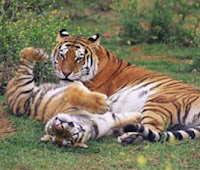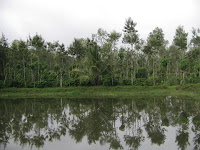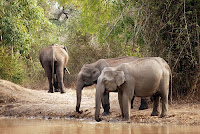Namdapha National Park
Situated in Arunachal Pradesh, 150 km from Miao, Namdapha National park stretches across an area of 1985 sq km. Being one of the largest national parks in north-east region, this park is situated on the Indo-Burma border. This park mainly covers high altitudes of up to 4500 m.

This park had a typical stock of flora and fauna. The lush green tropical rain forests are the breeding ground of a variety of animals and birds. Best time to visit this park is in the months of October and April.
Pakhui National Park
Located in East Kameng district in Arunachal Pradesh, Pakhui Wildlife Sanctuary is spread across 862 km. This park lies in the headquarters of Seijusa in the southwestern side of Arunachal Pradesh. Kememng River flows on its western side, Pakke River in the eastern side and Assam surrounds it on the south. The total area of Pakke Tiger Reserve was actually the area of Pakke Reserve forest. It was declared as Camo Sanctuary in 1977. in 2002 though it was declared as Pakhui Wildlife Sanctuary and finally declared as a reserve in 2004 under the Project Tiger scheme. The sanctuary houses a spectacular range of wildlife species like leopard, tiger, jackal, clouded leopard, fishing cat, jungle cat, wild dog, wild boar, bison, sambar and hog deer, elephant, barking deer and rhesus macaque. The best time to visit this place is between the months of October and April.
Nagarjunasagar- Srisailam
This is one of the largest wildlife sanctuaries in India situated 29 km away from Macherla and is spread across Kurnool, Guntur, Mahaboobnagar, Prakasam, and Nalgonda districts. This park spans an area of 3568 sq km. Surrounded by Nallamalai hills in south and Krishna River on the northern side, this sanctuary gets its name from the reservoir Nagarjunasagar. The sanctuary houses one of the oldest geological structures called ‘Archaean’ which is believed to be 2000 million years old. The major indian wildlife attractions here are Tiger, Leopard, Sloth Bear and Hyena. Tigers are extremely nocturnal and rarely seen here. Once home to 100 tigers, the tiger

population in the park has fallen drastically. Additional animal species spotted here are Spotted Deers, Mouse Deers, Sambhars, Wolves, Foxes, Chousingha Nilgai, Tree Shrews, Rayels, Wild Boars, and Indian Giant squirrels, Black Bucks, Jackals, Crocodiles, Wild Dogs, Sloth Bear, Panthers and Tigers. The best time to visit the park is between the months of October and June.
Valmiki National Park
Located in the West Champaran district of Bihar, Valmiki National Park covers an area of 335.64 sq km out of the 800sq. km of the Valmiki Sanctuary. This is the 18 Tiger Reserve, declared so in the year 1990 and ranks fourth in the density of tiger population. Surrounded by Royal Chitwan National Park of Nepal in the north and the river Gandak in the west, this park gets its name from the Valmiki Ashram located in the forests of Chitwan national Park. The forest has
dry Sal, moist deciduous trees containing reed beds and wet grasslands. The reserve inhabits tiger, various species of deer, serow, python, peafowl, leopard, wolf, hyenas, Indian civets, sloth bear, leopards, Jungle cats, etc. Animals like One horned rhinoceros and Indian bison are often found migrating from Chitwan to Valmikinagar. You can visit the park anytime of the year.
Palamau National Park
Palamau Sanctuary can pride itself in the fact that it is the ground for the world’s first tiger census. Situated 140 km west of Ranchi it is one of the best places to see wild elephants. Spread

in a total of 1026 sq km the forest here are rich with sal, teak trees and bamboo groves. It is believed there are 37 tigers, 62 leopards, 210 elephants and 249 bison in the park. The sanctuary has 200 villages where 8 local tribes live. The wildlife found here is wolf, sloth bear, deer, leopard, python, peafowl, sambars, nilgais, leopards, hyenas, Indian civets, jungle cats, hog deer and wild dogs. The best time to visit the park and sanctuary is between the months of October and June.
Bhadra National Park
Located in the tropical green jungles of Chikmagalur district 275 km from Bangalore, Bhadra Wildlife Sanctuary is spread in an area of 492.46 sq km. Initially the sanctuary was called Jagara Valley Game Reserve and was declared as the 25th Tiger Reserve in 1998. Bhadra flows in the sanctuary hence giving it its name. The sanctuary is well known as Muthodi Wildlife Sanctuary it is a great place to site tigers, Indian Bison, stripped Hyena and the flying lizard gliding in the woods. The park is dwelling place for more than 250 species of birds. The exceptional wildlife includes gaur, sloth bear, sambar, barking deer, mouse deer, wild boar, bonnet macaque, slender loris and Malabar giant squirrel. Best time to visit this place is between the months of June and October.


 Nagarhole used to be the private hunting grounds of the Maharaja of Mysore and was converted to a 285 sq kms Wildlife sanctuary in 1955. It was expanded and achieved National Park status in 1983. Nagarhole is around 220 kms from Bangalore and takes about 4 hours by road but the journey is worth when you experience the wildlife from such close quarters.
Nagarhole used to be the private hunting grounds of the Maharaja of Mysore and was converted to a 285 sq kms Wildlife sanctuary in 1955. It was expanded and achieved National Park status in 1983. Nagarhole is around 220 kms from Bangalore and takes about 4 hours by road but the journey is worth when you experience the wildlife from such close quarters.













